What to Feed Young Deer After Nursing
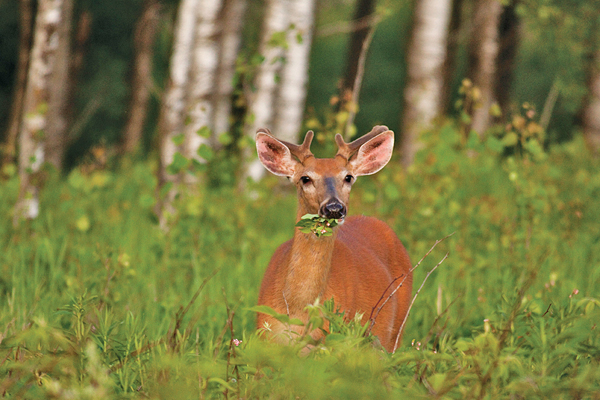
If you want to maximize the potential of your deer herd, it's critical to mind the nutritional requirements of all of the deer inhabiting your land, not just the mature bucks. Photo courtesy of Linda Freshwaters Arndt/windigoimages.com.
Just like humans, whitetail deer need a well-rounded diet throughout the year. During different seasons, the nutritional requirements of bucks, does and fawns will vary slightly, but all three need water, protein, energy (fats and carbohydrates), calcium, phosphorus, sodium and fiber. The key for managers is to provide the deer with what they need most, when they need it most. By breaking down the nutrition calendar into the four seasons and by discussing the specific need of bucks, does and fawns, we can determine the optimal feeding and food plot strategies for your deer herd.
Spring Requirements
The arrival of spring is easy to recognize. Air and soil temperatures begin to rise and lush green growth starts to canvas the forest floor. Deer recognize this too, as that emerging green growth usually is the best natural browse they encounter each year.
At this point in the year, bucks are still recovering from the rut and the previous winter. They're looking to rebuild muscle, so protein is absolutely critical. Bucks will also begin growing their new antlers by the end of spring, a function also requiring a high protein diet but also plenty of calcium and phosphorus.
Does are near their fawning dates and thus need to prepare their bodies for nursing, which will deplete their fat stores throughout the summer. Does also have to support a growing fetus in the third trimester, giving it the best chance to survive through the summer. To do this, they are still in need of energy to maintain their body condition and protein to aid the development of the fetus.
It is rare to have fawns at the onset of spring but if you do they will be mostly dependent on nursing for their nutritional needs, increasing the importance of energy and protein for the adult does. Bucks, does and fawns also need plenty of sodium during the spring because their daily intake of water is increased significantly by the lush browse.
Spring Provisions
Supplemental feeding, food plots and mineral supplements are all very beneficial to the deer herd in spring. Provide a high-protein (17-20 percent) feed in trough or gravity feeders (so as not to limit the deer's intake). I like to start my protein feeding program around May 1 and continue it throughout the summer. As the name suggests, supplemental feed will supplement new browse and spring food plots by providing additional minerals and fats that native browse and most food plot species lack.
When planning food plots for the spring, it is beneficial to look backwards at fall and winter. I think it is critical that if you plant annual food plot blends that you should be sure that there is an adequate clover component in each blend. By simply mowing the plots in the early spring to release the clover, you can have a fantastic, high-protein food source well into summer.
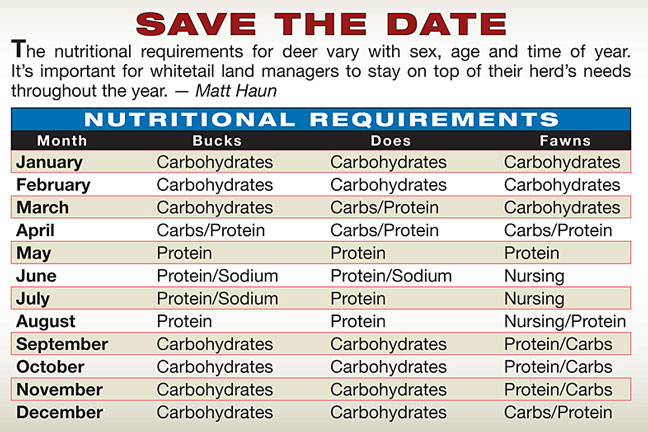
In some parts of the country and for some managers, clover seems to be the "magic plant." I use clover to fill my nutritional gaps between annual planting. It compliments a year-round program by thriving as forage from February to late May.
Mineral supplements are also useful during this time because they fill a need for sodium, calcium and phosphorus. When evaluating supplements, be sure that there are at least two parts calcium to each part phosphorus in the blend. I like to place mineral stations very close to my feeding areas because they are easier to monitor and maintain. Plus, deer are already eating there, so they can utilize the mineral site at the same time.
If you can't afford supplemental feed and/or don't have good food plots, you can also choose areas of concentrated favored browse and fertilize them with a "generic" fertilizer at a rate of 200-400 lbs per acre to significantly increase the quality of native browse. You can also make your own mineral blend that is simple, affordable and effective.
Summer Requirements
Summer in the South can be the most brutal season of the year for a whitetail deer herd. Drought conditions, temperatures in the triple digits, nursing fawns and parasites combine to make it difficult for a deer to survive, let alone grow. Although the North typically has more mild summers, herd nutrition requirements are very similar nationwide.
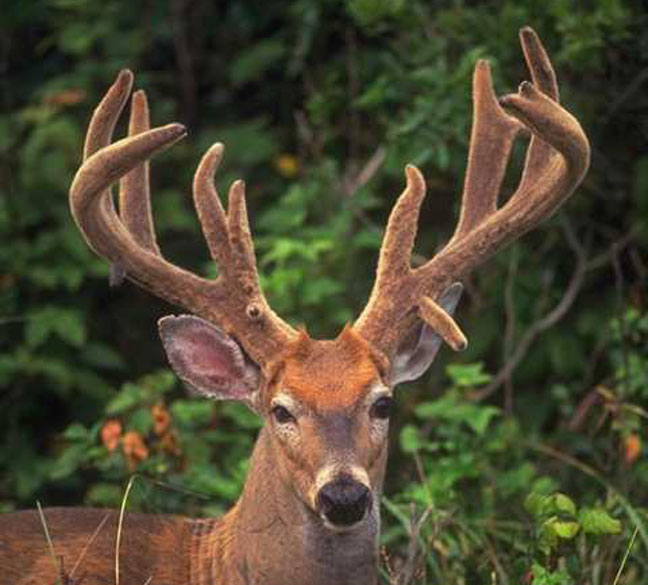
Bucks are growing antlers during the summer, which means a substantial percentage of a buck's calcium intake is going straight to its head. Likewise, hardened antlers are approximately 30 percent calcium and phosphorus. Obviously, protein, calcium and phosphorus are all critical to antler growth and development. Does usually give birth in late spring or early summer depending on the region. A nursing doe uses -- and loses -- more nutrients and energy than any other class of deer. It is critical for nursing does to pass on proteins and energy through their milk to the growing fawns.
By the end of summer, fawns will start to wean but are still in need of a high-protein diet to ensure good muscle development and growth rates going into fall. Summer is the most important time for proper nutrition. Antler development and fawn growth are taking place, while does are replenishing and recovering from fawning.
Summer Provisions
High-quality food is the name of the game in summer. Productive, high-protein food plots in peas, beans or lab-lab can provide up to 35 percent protein when properly fertilized and are also very palatable, so your deer are able to digest most of the protein and nutrients that they consume.
When planting these annual plots in late spring, be sure to think beyond summer and take advantage of combining some later-maturing grain sorghum, corn, or milo to the plots. These larger-seeded grains can be planted together with the legumes, but I prefer to plant them by themselves in small patches or in strips along the edges of fields. By keeping them separate, seed production in the grains and leaf production in the legumes can be maximized. By using the grains to border the fields, you also provide cover and edge habitat around your summer plots.
Supplemental feed in summer is also extremely important. If you have to pick one time of year to provide your deer with supplemental feed, summer is it. Be sure that your feeders are accessible by fawns, as they are the most critical deer in your herd to feed. The feed should be as high in protein as you can afford but does not need to exceed 20 percent. Mineral supplements will be utilized regularly during the summer and should be refreshed at least once during this period.
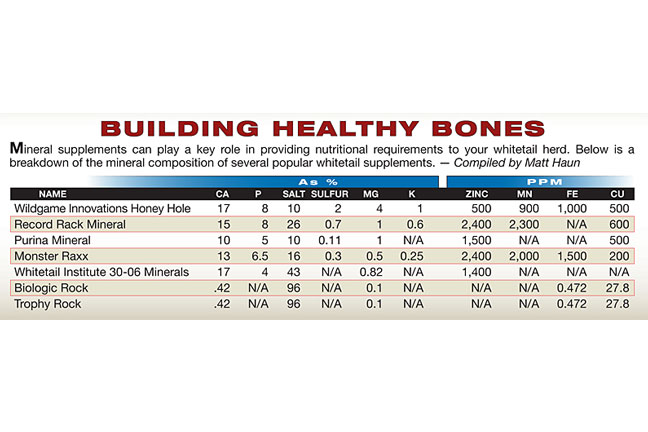
One item typically not mentioned when talking about deer nutrition that is extremely important in the summer is water. Many states experienced record drought and heat waves in the summer of 2011. Providing your deer herd with areas to water is important throughout the year, but it's especially critical in the summer.
The best way that I've found to achieve this goal is to simply dig or push out a hole in a natural drain. The hole should be at least 6 feet deep on the "deepest end" and should be built in the early fall so that it can "capture" as much rain as possible prior to summer. If you have extremely porous soils, you may need to line the site with clay or a synthetic liner. Deer will utilize these water holes almost immediately and with great frequency in times of drought.
Fall Requirements
Fall is when bucks are preparing for battles and breeding, does are trying to get in shape for pregnancy and fawns are attempting to put fat on their frames to endure winter. Overall, every deer in your herd is trying to increase fat stores, and to do that they need "energy."
Simply put, energy comes from fats and carbohydrates and is among the most important components of a deer's diet, second only to water. Energy is required for all bodily functions and physical activity to take place. Carbohydrates and fats are what give whitetails the energy needed to survive, and they can be stored as fat throughout the fall for use during the rut and succeeding winter.
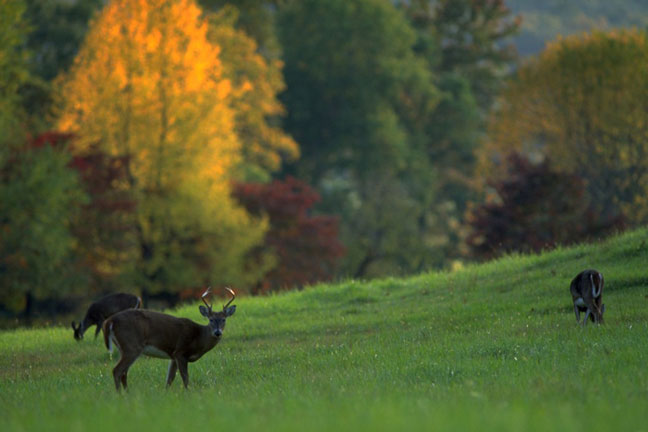
Bucks use this fat as stored energy during the rut, when they abandon food sources to chase females. After the fat stores are gone, the buck's body will begin to burn muscle tissue for energy, which weakens the buck significantly going into winter. Does use the stored fats for energy to hold them through winter and help them in delivering proper nutrients to their developing fetus. Fawns simply need to increase fats so that they do not lose any of the muscle they worked all spring and summer to produce.
Fall Provisions
Mother Nature does a great job providing carbohydrates and fats to deer in the form of acorns and hard mast production -- most of the time. Agriculture in parts of the country also plays a key role in carbohydrate and fat production through grains such as corn and milo and other crops like sunflowers and peanuts. Food plots, however, often provide the deer with the proper forage in the fall to help digest those carbohydrates more easily and efficiently.
Your summer plots will likely remain viable into the early fall and might even produce beans or peas that will be utilized throughout fall. Those food plot borders or "edges" that you planted will not be a great source of carbohydrates for your deer in the form of mature seed heads or corn.
If you didn't plant summer plots and are going to plant in the fall, I suggest a good blend of grasses and legumes. I like blends that combine cereal grains (with the exception of ryegrass), brassicas, and clovers. I've found that these blends tend to provide attraction and nutrition and do so for 7 months or more each year.
In years of mast crop failure, especially in the north, it can aid the deer herd tremendously to provide supplemental feed. As always, this should be done in accordance with local laws regarding the feeding of wildlife. Although deer don't "need" the high-protein feed as much as they did in summer, it is important to transition them from a diet heavy in protein into rations of grain and or hay. A deer's digestive system needs to grow the proper bacteria in order to properly digest a diet that is mostly grain, especially in times and areas where grain would not otherwise be available to them.
If deer are not properly conditioned, they can develop rumen acidosis, a potentially fatal condition. Any change in a deer's diet that you want to institute should be done so gradually. I start to transition from pellets to grain (if needed) in mid- to late October, and I do so by mixing corn into the pelleted feed at a rate of about 40 percent corn the first week and increasing 10-15 percent weekly until I'm feeding 80 percent corn and 20 percent pellets throughout fall and winter.
Mineral supplementation is typically not utilized much in the fall because deer aren't growing in the fall, nor do they have the sodium deficiencies that we encounter in spring and summer. The minerals will remain in the soil through fall and winter though, and it doesn't hurt to refresh them in the fall.
Winter Requirements
Deer in the north are just trying to survive until spring, and in the South, they're working on replenishing lost fats and overall bodyweight from the long rut. January through April can be a very dangerous time for northern deer herds, especially in years of heavy snowfall. Bucks, does and fawns need fat and carbohydrates to sustain their body weights until spring, when they will begin to grow again. Like most animals and plants, deer do not actively grow in the winter.
Winter Provisions
Remnants from agriculture production and woody browse make up the largest part of a deer's diet throughout winter. Fall food plots can also play a key role, so long as deer can get to them. Snow and ice can impact your herd's access to food plots greatly, and in some cases you might be able to help out by using an all-purpose plow, rock rake, bucket, or even a snow plow to increase the accessibility of your food plots.
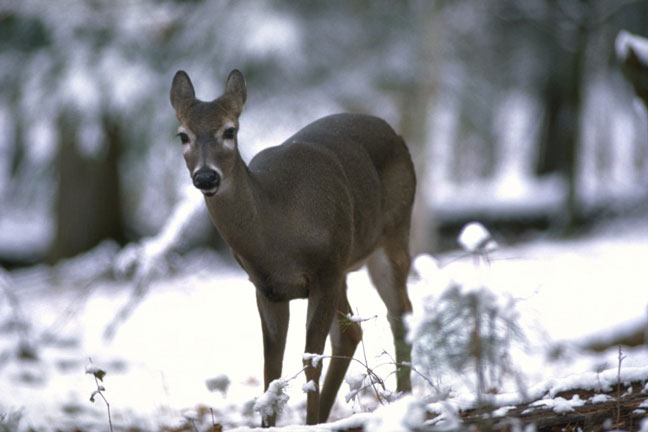
Energy spent digging through snow/ice to reach a food plot can be decreased significantly if you dig through it for them. The brassicas or radishes in your fall blend will most likely have large root vegetables on them by winter, which can provide very highly sought after carbohydrates and simple sugars and make the plots very attractive for late-season hunting.
Supplemental feeding can be done, but with the same caution as in the fall, make sure to gradually transition the deer to the feed, even if you think they look like they're starving. In fact, its more important for a "starving" deer to be transitioned slowly into the high-carbohydrate, grain diet because their rumens are more likely to lack the key microbes and bacteria necessary to process the grain.
Conclusion
Age, nutrition, and genetics are what it takes to grow big bucks. Nutrition is the easiest of these to control. Providing the maximum level of nutrition and paying attention to quality, quantity and timing will put you on the path to a successful program. A successful nutrition program will yield healthy deer herds, and healthy deer herds produce quality bucks.
It is important to remember a few things with regard to planting for and feeding deer:
- Deer do not grow in fall or winter, so spring and summer nutrition is much more important to herd health and quality.
- Do not rapidly transition your deer herd into a specific type of diet. Always make the change gradually.
- Make sure you check local laws and regulations prior to using supplemental feed or minerals on your property.
Source: https://www.northamericanwhitetail.com/editorial/whitetail-nutrition-calendar/263409
0 Response to "What to Feed Young Deer After Nursing"
Post a Comment